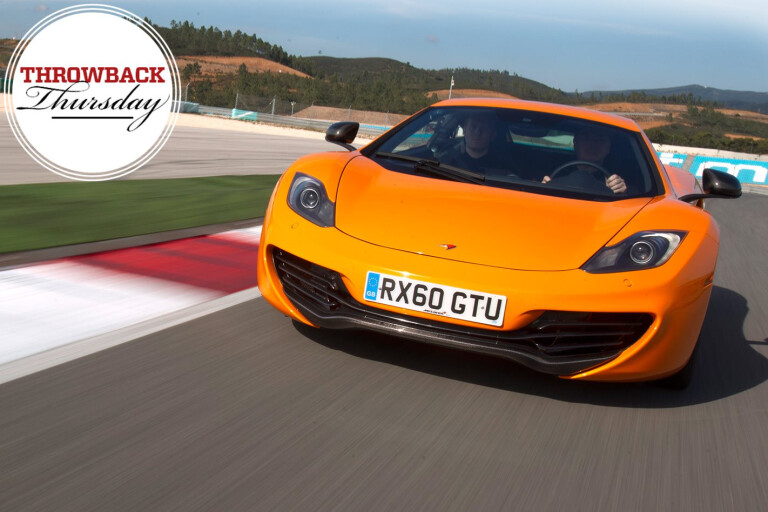
McLaren’s new supercar has the Ferrari 458 Italia squarely in its sights. But does the Mac daddy’s stunning tech and staggering performance actually push it into the ‘hyper’ class above?
First published in the March 2011 issue of Wheels magazine, Australia’s most experienced and most trusted car magazine since 1953.
AT THE scheduled 2:45pm precisely – and I mean to the second, because this is McLaren – Ron Dennis walks into the room and tells us that he has built the best-handling sports car in history. I’m about to drive the McLaren MP4-12C, an entirely new supercar from an entirely new supercar maker, but one with about the most perfect pedigree imaginable. Yes, McLaren made the F1, but that was nearly 20 years ago, and the SLR it built for Mercedes wasn’t the car it would have chosen to build itself. This time, Ron is doing it on his own, from scratch and on a grand scale. He and his fellow shareholders have spent A$1.3b developing the first of a range of supercars on which he will build a business three times bigger than his F1 team within five years, and which, from a standing start today, will be as direct a rival to Ferrari on the road as it is on the track.
Never has a sheet of paper been blanker. The new McLaren Automotive didn’t have to build the 12C around an existing engine or engineering philosophy or factory. This is simply the very best car it could make. And when the famously detail-obsessed, über-perfectionist Dennis stands in his surgically-clean, A$500m Bond-villain headquarters sunken into the English countryside and tells you that the result is objectively, measurably, scientifically the best-handling sports car ever made, you need to get straight into the car to find out if he’s right.

 The noise changes in the same way as you use up each gear, starting with a business-like, V8 induction rumble just behind your head but pitching backwards and focusing around the exhausts in a hard, hollow, flat-plane howl as you get ready to change up again. The shifts to fourth, fifth and sixth show less contrast but – again like the Veyron – the rate of acceleration just doesn’t seem to let up until you’re closing in on 300km/h. Not having tried a big stop before, I lifted at 309 and nailed the brakes. The cold, standard iron rotors, aided by the airbrake, felt like they were pulling us backwards, though the rear end remained nailed to the deck and the centre of pressure seemed barely to shift. In a few hundred metres we were legal again and I was left looking down a disappointingly long stretch of unused straight. Pity; even on this very average couple of kilometres of dual carriageway, the magic 200mph (322km/h) would have been on the cards. But Ron had already proved one point, at least.
The noise changes in the same way as you use up each gear, starting with a business-like, V8 induction rumble just behind your head but pitching backwards and focusing around the exhausts in a hard, hollow, flat-plane howl as you get ready to change up again. The shifts to fourth, fifth and sixth show less contrast but – again like the Veyron – the rate of acceleration just doesn’t seem to let up until you’re closing in on 300km/h. Not having tried a big stop before, I lifted at 309 and nailed the brakes. The cold, standard iron rotors, aided by the airbrake, felt like they were pulling us backwards, though the rear end remained nailed to the deck and the centre of pressure seemed barely to shift. In a few hundred metres we were legal again and I was left looking down a disappointingly long stretch of unused straight. Pity; even on this very average couple of kilometres of dual carriageway, the magic 200mph (322km/h) would have been on the cards. But Ron had already proved one point, at least.
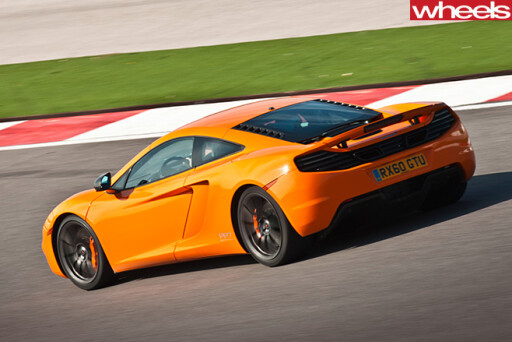 But we’re getting ahead of ourselves. Hard not to, when you’re presented with a new, road-going McLaren. Let’s pause for a mental x-ray of the MP4-12C, to see what they drew on that blank sheet. Actually, there was one prerequisite for the 12C; having introduced carbon monocoques to both Formula 1 in 1981 and to road cars with the F1 in 1993, the 12C was always going to have a black tub, not least to give it one clear initial perceived advantage over the aluminium spaceframe 458. The Monocell weighs 75kg and its hollow sections are massively stiff; aluminium subframes attach to it and carry the front and rear mechanical packages. The entirely new, dry-sumped 441kW M838T engine, built by Ricardo in the UK to McLaren’s design sits oddly low in the chassis. Behind it is the Graziano gearbox, again a McLaren design, its major innovation the ‘pre-cog’ function that allows you to pre-load the clutch by part-pulling the shifter, giving an almost instant change when you pull to its final click. The diff is open, saving 20kg, the traction issues being handled by the ESC system. Brake Steer is the big news here; it brakes the inside wheel to pull the nose tight into a corner and is essentially the same system that was developed by McLaren for its 1997 MP4/12 F1 car, then banned.
But we’re getting ahead of ourselves. Hard not to, when you’re presented with a new, road-going McLaren. Let’s pause for a mental x-ray of the MP4-12C, to see what they drew on that blank sheet. Actually, there was one prerequisite for the 12C; having introduced carbon monocoques to both Formula 1 in 1981 and to road cars with the F1 in 1993, the 12C was always going to have a black tub, not least to give it one clear initial perceived advantage over the aluminium spaceframe 458. The Monocell weighs 75kg and its hollow sections are massively stiff; aluminium subframes attach to it and carry the front and rear mechanical packages. The entirely new, dry-sumped 441kW M838T engine, built by Ricardo in the UK to McLaren’s design sits oddly low in the chassis. Behind it is the Graziano gearbox, again a McLaren design, its major innovation the ‘pre-cog’ function that allows you to pre-load the clutch by part-pulling the shifter, giving an almost instant change when you pull to its final click. The diff is open, saving 20kg, the traction issues being handled by the ESC system. Brake Steer is the big news here; it brakes the inside wheel to pull the nose tight into a corner and is essentially the same system that was developed by McLaren for its 1997 MP4/12 F1 car, then banned.
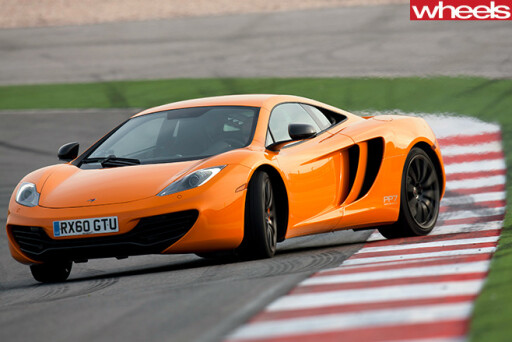 The suspension is by wishbones and coil springs, but there are no anti-roll bars. Instead, the ProActive Chassis Control adaptive damping system links each damper hydraulically with the one on the same axle and the one diagonally opposite. It allows the 12C to completely decouple roll stiffness from axle articulation; if the car senses roll, the system stiffens to mimic an anti-roll bar; otherwise, each wheel can move completely independently for the optimum ride. Like the transmission, but independent of it, there are three, driver-selectable settings: ‘normal’, ‘sport’ and ‘track’, each also raising the threshold at which the ESC will cut in. Some secret combination of button-pushes will allow you to switch it off completely. The standard brakes mate an iron rotor to an aluminium bell to save 8kg, or you can upgrade to carbon-ceramic discs. The airbrake helps keep the car’s weight balance neutral, allowing more rear brake pressure.
The suspension is by wishbones and coil springs, but there are no anti-roll bars. Instead, the ProActive Chassis Control adaptive damping system links each damper hydraulically with the one on the same axle and the one diagonally opposite. It allows the 12C to completely decouple roll stiffness from axle articulation; if the car senses roll, the system stiffens to mimic an anti-roll bar; otherwise, each wheel can move completely independently for the optimum ride. Like the transmission, but independent of it, there are three, driver-selectable settings: ‘normal’, ‘sport’ and ‘track’, each also raising the threshold at which the ESC will cut in. Some secret combination of button-pushes will allow you to switch it off completely. The standard brakes mate an iron rotor to an aluminium bell to save 8kg, or you can upgrade to carbon-ceramic discs. The airbrake helps keep the car’s weight balance neutral, allowing more rear brake pressure.
And the numbers? McLaren has kept them quiet until now, and Ferrari isn’t going to like them. At 1434kg with fluids and in standard trim, the 12C is around 50kg lighter than the 458. It gets to 100km/h in 3.3sec, a tenth quicker than the 458, but you can cut two-tenths off that by choosing the optional Corsa tyres. Depending on whose figures you use, it’s around half a second quicker than a McLaren F1 to 200km/h at 9.1sec, or 8.9 on the Corsas. Unofficially, it will get to 300km/h in around 26 seconds, a couple behind the F1 as the older car’s greater power starts to show. McLaren is claiming a 330km/h top speed, a comfortable margin above the Ferrari’s 325km/h, but conservative, say its people privately. I’d have to agree. From the way it was still pulling at 309, there was plainly a lot more to come.
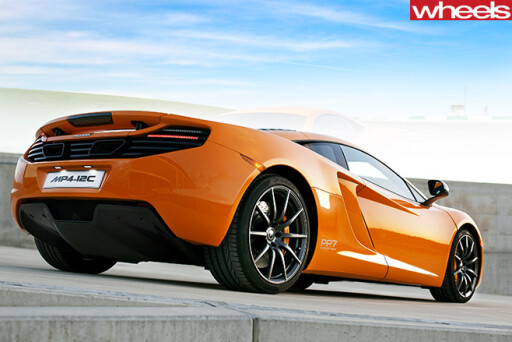 So you walk up to the 12C for the first time, carbonfibre lozenge of key in your hand. It is smaller in every dimension than the 458 – other than the wheelbase – and looks smaller than the numbers suggest. Styling is subjective; you can see the pictures, you’ll decide for yourself. But while the 458 is a deliberately arresting sight, the 12C seems to have gone deliberately in the other direction. McLaren’s race cars and sole road car put function over form, so maybe we shouldn’t expect visual fireworks from this new brand. Maybe they felt a look-at-me supercar just wouldn’t fit the times they’re launching it in, and chose to make the 12C look more Lotus than Lamborghini.
So you walk up to the 12C for the first time, carbonfibre lozenge of key in your hand. It is smaller in every dimension than the 458 – other than the wheelbase – and looks smaller than the numbers suggest. Styling is subjective; you can see the pictures, you’ll decide for yourself. But while the 458 is a deliberately arresting sight, the 12C seems to have gone deliberately in the other direction. McLaren’s race cars and sole road car put function over form, so maybe we shouldn’t expect visual fireworks from this new brand. Maybe they felt a look-at-me supercar just wouldn’t fit the times they’re launching it in, and chose to make the 12C look more Lotus than Lamborghini.
You run your fingers over the proximity sensor hidden in the deep air scoop cut into the scissor door to open it upwards. The square sill of the carbon tub is higher and wider than most but not difficult to climb over. Once in, the door’s grab handle is an easy reach forward and up, and it pulls down shut with little effort. Ahead of you, the instruments are pretty simple; big central tachometer, of course, digital speedo, gear indicator to the right, with status bars for the fluids and a reminder of which handling and performance setting you’re in. The switchgear has plainly been thought about hard and rationalised to the bare, logical minimum. The air-con controls are in the door, just where your right hand falls. The audio and sat-nav are controlled by the upright, iPhone-like central touchscreen. The transmission and handling modes are controlled by two rotary switches below that and are easily found without taking your eyes off the road, but can’t be operated until you’ve hit the ‘active’ button, so that letting your 10-year-old play in the cabin during the week won’t result in a nasty surprise when you turn into your first wet corner of the weekend.
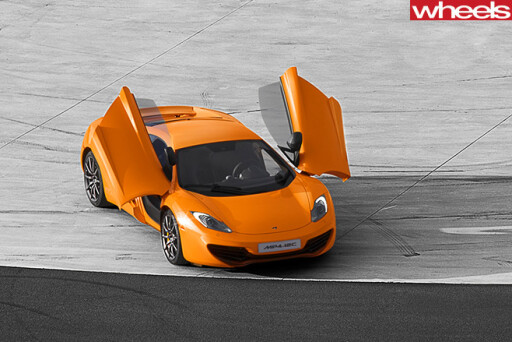 Thumb the starter and the engine answers with an even V8 rumble; no Aston-esque, attention-grabbing blip. You pull the right lever towards you to select first, remembering to keep your left hand out of the way; it’s a proper, F1 rocker-change, hinged behind the wheel, which itself is a small, deep and lovely thing, using the same radii as the current F1 car. And in auto mode, this 330km/h car just trundles off into the traffic, the gearbox changing early and imperceptibly, the ride unbelievably compliant over bad surfaces, the visibility perfect both past the narrow A-pillars and even rearwards. Despite being so low, the headroom is huge, the cabin feels airy and the driving position is straight and perfect. It’s quiet – maybe too quiet; you only get the full howl if you switch the three-stage transmission into maximum-attack mode, which also opens up the exhausts. Frankly, it doesn’t feel like a supercar at all. Aren’t there supposed to be compromises? Aren’t you meant to smack your head on the way in, and suffer some contorted driving position, and live in constant fear of scraping a flank on a pillar? Not in this car. Before Ron made that big claim for its handling, McLaren’s official spokespeople were wary of over-promising. The one thing they did promise was a broader range of ability than any other supercar, and on that, they’ve delivered. This is a car you’ll feel comfortable in faster, and drive faster sooner, than any other.
Thumb the starter and the engine answers with an even V8 rumble; no Aston-esque, attention-grabbing blip. You pull the right lever towards you to select first, remembering to keep your left hand out of the way; it’s a proper, F1 rocker-change, hinged behind the wheel, which itself is a small, deep and lovely thing, using the same radii as the current F1 car. And in auto mode, this 330km/h car just trundles off into the traffic, the gearbox changing early and imperceptibly, the ride unbelievably compliant over bad surfaces, the visibility perfect both past the narrow A-pillars and even rearwards. Despite being so low, the headroom is huge, the cabin feels airy and the driving position is straight and perfect. It’s quiet – maybe too quiet; you only get the full howl if you switch the three-stage transmission into maximum-attack mode, which also opens up the exhausts. Frankly, it doesn’t feel like a supercar at all. Aren’t there supposed to be compromises? Aren’t you meant to smack your head on the way in, and suffer some contorted driving position, and live in constant fear of scraping a flank on a pillar? Not in this car. Before Ron made that big claim for its handling, McLaren’s official spokespeople were wary of over-promising. The one thing they did promise was a broader range of ability than any other supercar, and on that, they’ve delivered. This is a car you’ll feel comfortable in faster, and drive faster sooner, than any other.
 But you didn’t buy it to go shopping. We know that it is titanically quick; we still had to find out if the chassis was as good. The steering feels weighty at low speeds and deliberate at big speeds; in between it’s precise, perfectly geared and never a frustration, but never fizzes the way you’d hope it would. It’s also flattered by that astonishing damping system. You do need to switch between settings; ‘normal’ can get too wobbly at speed over a poor surface, and ‘track’ can be too harsh. But one will be right for the road you’re on, the 12C balancing flat with flow better than anything else I’ve driven. The rack also benefits from never having to suffer understeer for long; either brake-steer and the gentle but utterly impassive, unfoxable stability control will kill it, or you can tell them to intervene later and sort it out yourself, that truck-like torque sending the rear end slewing out on command, the car’s bigger brain bringing it back in line after a precisely-metered amount of fun if your brain isn’t quick enough.
But you didn’t buy it to go shopping. We know that it is titanically quick; we still had to find out if the chassis was as good. The steering feels weighty at low speeds and deliberate at big speeds; in between it’s precise, perfectly geared and never a frustration, but never fizzes the way you’d hope it would. It’s also flattered by that astonishing damping system. You do need to switch between settings; ‘normal’ can get too wobbly at speed over a poor surface, and ‘track’ can be too harsh. But one will be right for the road you’re on, the 12C balancing flat with flow better than anything else I’ve driven. The rack also benefits from never having to suffer understeer for long; either brake-steer and the gentle but utterly impassive, unfoxable stability control will kill it, or you can tell them to intervene later and sort it out yourself, that truck-like torque sending the rear end slewing out on command, the car’s bigger brain bringing it back in line after a precisely-metered amount of fun if your brain isn’t quick enough.
We’re not going to say that the MP4-12C is the best-handling car in the world. But if you had to pick three cars to fight for that title, the new McLaren would be one of them. When Ron says that the 12C is measurably the best-handling car in the world, he means that they’ve strapped it and its rivals to rigs and tested them. “We scientifically know,” he says. “It’s better in every parameter we can measure.” But some things aren’t open to objective measurement. The only real flaw we can find with the MP4-12C is its flawlessness. It’s like a child prodigy; generally begotten by hyper-ambitious parents, staggering in its abilities, perfect in its behaviour, but oddly cool and aloof. The other kids seldom want to hang out with the 12-year-old concert violinist. Criticising a car for being too perfect seems odd, but in a supercar character and emotion and idiosyncrasy and simple, fidgety excitement count for a lot, too. You might buy and love the McLaren for its tech and its many measurable superiorities. But Ron’s numbers don’t tell the whole story, and the Ferrari ain’t outnumbered yet.
SPECS
Model: MP4-12C
Drivetrain: mid-engine (north-south), rear drive
Engine 3.8-litre V8, dohc, 32v, twin-turbo
Transmission: 7-speed dual-clutch
Power: 441kW @ 7000rpm
Torque: 600Nm @ 3000-7000rpm
Power-to-weight: 308kW/tonne
Torque-to-weight: 418Nm/tonne
Weight: 1434kg
Price: $550,000 (estimated)

COMMENTS